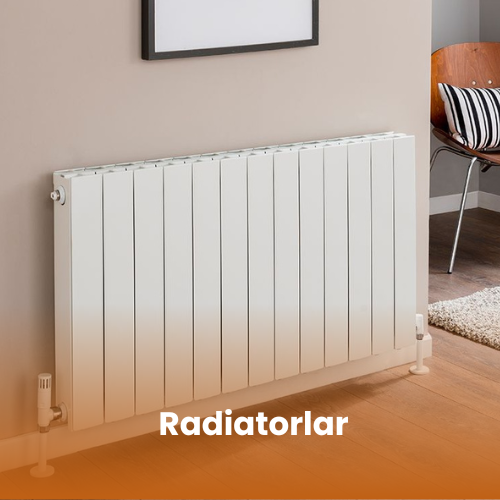Radiators

Radiators
What is a radiator?
A brief definition
A radiator is a device used to provide heat in enclosed spaces such as homes and offices. Typically mounted on walls, it distributes warmth via hot water or electricity, creating a comfortable indoor environment.
Main function
The primary purpose of a radiator is to evenly distribute heat across the room. By receiving warmth from the heating system, it emits heat into the air, ensuring consistent thermal comfort.
History of radiators
Early radiators
The origins of radiators date back to the early 19th century. Russian inventor Franz San Galli is credited with introducing the first models. Before this, heating relied on primitive methods, and radiators revolutionized home comfort.
Evolution into modern systems
With technological advancement, radiator design evolved from bulky cast iron models to sleek, energy-efficient units made of aluminum and steel. Today, designer radiators serve both functional and aesthetic purposes.
Types of radiators
Water-based radiators
These are the most commonly used types, powered by central heating systems or combi boilers that circulate hot water.
Panel radiators
Slim, lightweight, and modern in appearance, panel radiators are ideal for residential use.
Cast iron radiators
Known for their durability and heat retention, these are often found in older homes or restored interiors.
Electric radiators
These operate independently using electricity and are ideal for spaces without a central heating system.
Oil-filled radiators
Portable and safe, these radiators heat oil internally and radiate warmth gradually.
Designer radiators
Modern radiators that double as decor, especially useful in bathrooms or stylish living spaces.
How radiators work
Convection and radiation
Radiators distribute heat through convection (airflow) and radiation (direct emission), ensuring balanced room temperatures.
Heat distribution mechanism
Hot water flows through the radiator’s interior, heating its surface. The warmth is then transferred to the surrounding air.
What to consider when choosing a radiator
Room size
The radiator's power output must match the room’s dimensions. Oversized units waste energy; undersized ones underperform.
Heating requirement
Consider daily usage, sunlight exposure, and heat loss when estimating heating needs.
Energy efficiency
Opt for high-efficiency models to reduce energy bills and environmental impact.
Design and aesthetics
Radiators today come in various shapes and finishes, complementing your interior style.
Installing a radiator
Professional installation
For complex systems, hiring a licensed technician ensures safety and optimal performance.
Can you install it yourself?
Some electric units are DIY-friendly, but water-based radiators typically require expert setup.
Radiator maintenance and cleaning
Why cleaning matters
Dust and dirt reduce heat transfer efficiency, increasing energy consumption and reducing comfort.
Step-by-step cleaning guide
-
Turn off the radiator
-
Use a vacuum and cloth for surface dust
-
Clean inside with a radiator brush
-
Perform annual system flushing
Common radiator issues
Radiator not heating
Air trapped in the system is a common cause. Bleeding the radiator often resolves the issue.
Water leakage
Usually due to loose joints or corrosion—requires prompt repair.
Noises and air bubbles
Buzzing or gurgling sounds indicate air in the system or flow issues.
Radiators and energy savings
The role of thermostats
Thermostatic radiator valves allow precise temperature control, enhancing both comfort and efficiency.
Heat optimization tips
Avoid blocking radiators, install reflective panels, and position units under windows to maximize heat circulation.
Pros and cons of radiators
Advantages
-
Fast and reliable heating
-
Long service life
-
Diverse styles available
Disadvantages
-
Can occupy wall space
-
Uneven heat in larger rooms
-
Some models require regular maintenance
The connection between radiators and combi boilers
Radiators rely on combi boilers to supply hot water. If the boiler malfunctions, radiator performance is affected. The two work hand-in-hand as part of a unified heating system.
How to find affordable and quality radiators
Compare online prices, check user reviews, explore seasonal discounts, and consider local suppliers for the best deals.
Popular radiator brands and models
Brands popular in Azerbaijan
-
E.C.A
-
DemirDöküm
-
Baymak
European and Turkish manufacturers
-
Viessmann
-
Baxi
-
Buderus
Radiator pricing and market trends
Prices range from 60 AZN and above, depending on material, design, and capacity. Year-end and pre-season sales offer great value for money.
Myths and misconceptions about radiators
-
Myth: Radiators waste energy.
Reality: Efficient models help save energy. -
Myth: Radiators are harmful to health.
Reality: Proper ventilation prevents any health risks. -
Myth: All radiators are universal.
Reality: Each space requires a tailored solution.
The future of radiator technology
-
Smart radiator systems
-
Sensor-based temperature adjustments
-
Built-in energy storage
-
Wi-Fi and remote controls
Conclusion
Radiators remain a cornerstone of modern heating systems. With the right model and proper usage, they provide efficient, reliable, and cost-effective comfort. Choose wisely—your warmth depends on it.
